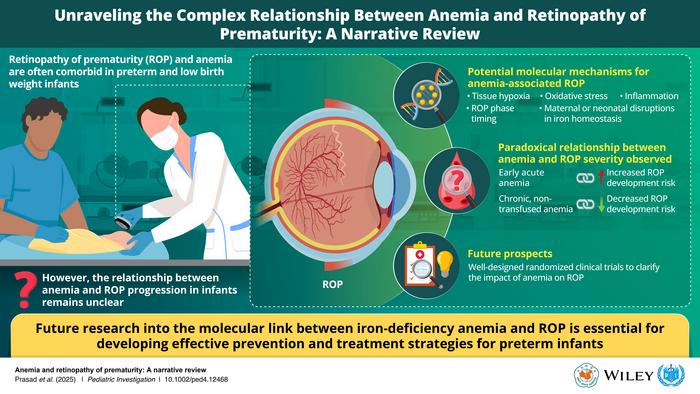
Retinopathy of Prematurity (ROP) stands as a significant threat to the vision of countless preterm infants globally, particularly those with extremely low birth weights, weighing less than 1,250 grams. The incidence of ROP has become increasingly concerning as neonatal care advances, highlighting the complex interplay of conditions affecting this vulnerable population. One such condition that demands our attention is anemia, which is prevalent among these infants and closely tied to the onset and severity of ROP.
Anemia is notably ubiquitous in preterm infants, with estimates indicating that nearly 90% of those classified as extremely low birth weight will experience need for blood transfusions at some point during their hospital stay. The reasons behind this high prevalence are multifactorial, but frequent blood draws for critical monitoring purposes play a leading role in exacerbating anemia. Moreover, preterm infants miss the crucial transfer of iron from their mothers during the third trimester of gestation, when approximately 70% of maternal iron is passed to the developing fetus.
The relationship between anemia and ROP is particularly critical because both conditions frequently coexist within the neonatal population. Comprehensively understanding how anemia influences the risk of developing ROP could improve clinical interventions and outcomes for these vulnerable infants. Recent research has shed light on the association, revealing that iron deficiency, a primary cause of anemia, may exacerbate conditions that lead to ROP.
Current literature discusses various mechanisms through which anemia may contribute to ROP, including tissue hypoxia, oxidative stress, inflammation, and the timing of anemia onset relative to the different phases of ROP. Each of these factors plays a crucial role in exacerbating the effects of reduced retinal oxygen levels, leading to impaired retinal vascularization and growth.
One critical mechanism is the role of iron deficiency in promoting hypoxia. Anemia inherently reduces the oxygen-carrying capacity of the blood, thereby diminishing oxygen delivery to bodily tissues, including the retina. The deficiency of iron creates additional complications by inhibiting enzymes critical for oxygen regulation. In low oxygen conditions—hypoxia—an adaptive protein known as hypoxia-inducible factor 1-alpha (HIF-1α) is activated, triggering the expression of various angiogenic factors, including vascular endothelial growth factor (VEGF). While normal levels of VEGF facilitate healthy blood vessel formation, excessive levels contribute to the pathological neovascularization seen in ROP.
Oxidative stress is another avenue through which anemia potentiates retinal damage. Preterm infants exhibit lower antioxidant levels compared to full-term infants, rendering them more susceptible to harm from reactive oxygen species (ROS). These species are byproducts of normal metabolic activity but become detrimental when accumulated in excess, resulting in endothelial cell damage and delayed retinal development. Furthermore, iron deficiency can intensify oxidative stress, further leading to retinal injury during the critical periods of ROP development.
Inflammatory responses triggered by anemia can also compound the risk to retinal health. The presence of systemic inflammation culminates in elevated cytokine levels, such as tumor necrosis factor-alpha and interferon-gamma, which exacerbate retinal injury during the evolution of ROP. The interdependence of anemia and inflammatory markers underscores the need for thorough explorations into their shared pathogenic pathways.
Interestingly, recent studies reveal a paradox in the association between anemia and the severity of ROP. Early anemia during the initial weeks of life has been correlated with heightened risks for developing ROP, while chronic anemia—especially when not treated with transfusions—may demonstrate a protective effect against severe ROP. This enigmatic relationship hints that the timing and management of anemia are critical, necessitating a careful evaluation of transfusion protocols and iron supplementation adherence across various neonatal care units.
Collectively, this body of research suggests that clarifying the nuances of how anemia influences ROP is imperative. There exists a critical need for randomized controlled trials designed to dissect the impact of anemia on ROP risk, focusing on factors such as timing, severity, management strategies, and relevant comorbid conditions. Pursuit of these studies will pave the way for a deeper understanding of how interventions can be tailored to mitigate this dual risk.
In conclusion, the interconnected nature of anemia and ROP poses significant challenges in the management of preterm infants. Although advances in neonatal care are evident, awareness and research into the underlying mechanisms linking these two conditions remain urgent. Addressing the knowledge gaps surrounding anemia’s role in ROP is essential for developing effective prevention and treatment strategies, ultimately improving clinical outcomes for the most vulnerable patients in our healthcare system.
Through continued exploration and targeted research efforts, we may uncover innovative approaches in managing both anemia and ROP, ensuring a brighter future for preterm infants who face the specter of these interrelated challenges.
—
Subject of Research:
Article Title: Anemia and retinopathy of prematurity: A narrative review
News Publication Date: 3-Feb-2025
Web References: https://doi.org/10.1002/ped4.12468
References: Pediatric Investigation
Image Credits: Pediatric Investigation
Keywords: Anemia, Retinopathy of Prematurity, Iron Deficiency, Neonatology, Pediatric Investigation, Vascular Endothelial Growth Factor, Oxidative Stress, Hypoxia, Inflammation, Preterm Infants.
Tags: anemia prevalence in preterm infantsblood transfusions in neonatal careclinical interventions for anemia and ROPconnection between anemia and ROPextremely low birth weight infantsimproving outcomes for preterm infantsiron transfer during pregnancyneonatal care advancementsneonatal population health challengespediatric anemia and retinopathypreterm infant vision healthunderstanding retinopathy of prematurity





